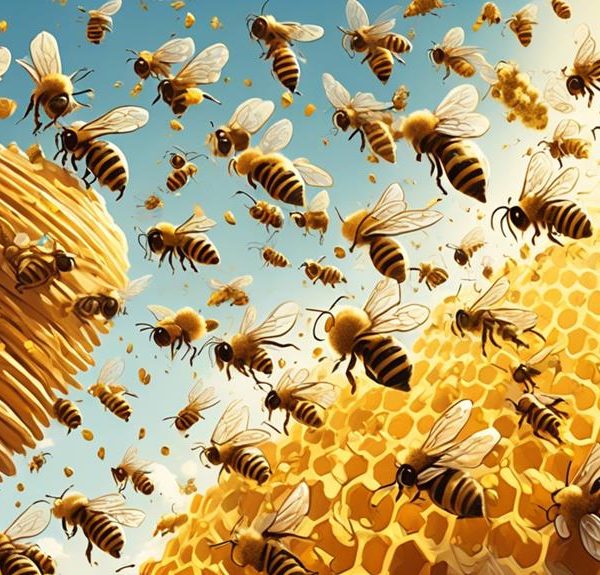Curious about charming bees? Discover the remarkable power of lemongrass oil in attracting bees in this captivating guide.
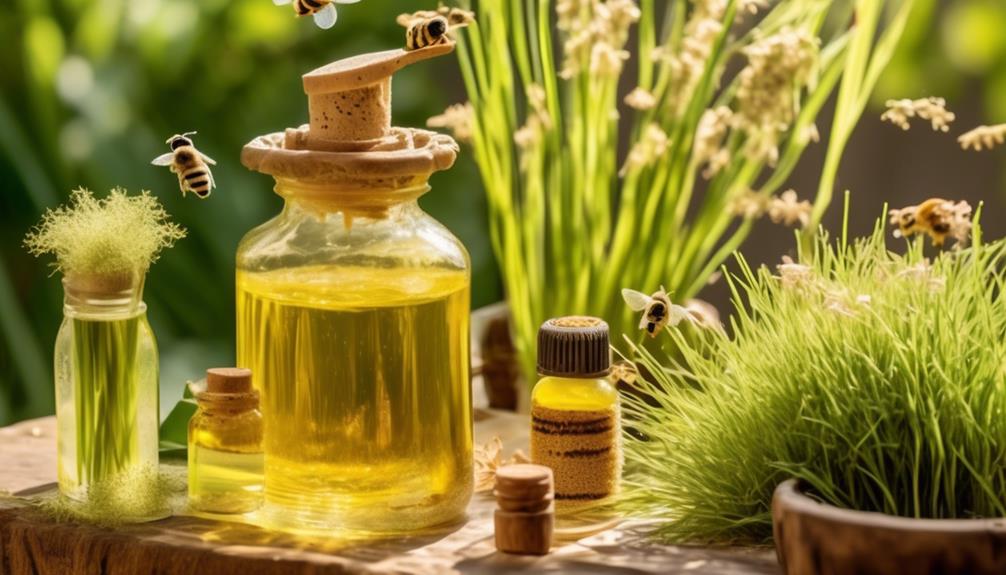
How to Use Lemongrass Oil to Attract Bees?
Imagine being able to command an entire army of bees with just a few drops of oil. That's right, you're closer than you think to becoming a bee whisperer.
The secret weapon? Lemongrass oil. This natural elixir is so potent to bees, it's as if they're under a sweet, irresistible spell. However, the real magic lies in knowing how to use it effectively.
So, are you ready to discover the fascinating world of bees and lemongrass oil? Well, you'll have to stick around to find out how.
Key Takeaways
- Lemongrass oil contains citral and geraniol, which are irresistible to bees.
- Bees have an innate response to citrus scents, triggering an immediate foraging response.
- Geraniol in lemongrass oil mimics the scent of a queen bee, attracting worker bees.
- Lemongrass oil should be diluted with a carrier oil and applied sparingly to bee-friendly plants or structures.
Understanding the Attraction of Bees to Lemongrass Oil
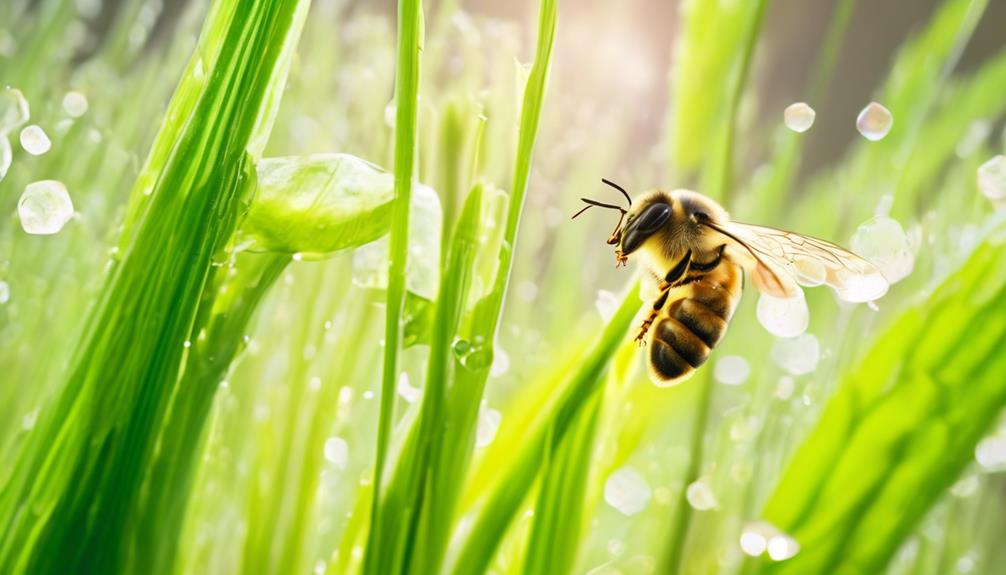
To truly appreciate the appeal of lemongrass oil to bees, it's crucial to delve into the unique chemical composition of this aromatic substance. The primary constituents of lemongrass oil are citral and geraniol, both of which are volatile organic compounds that bees find irresistible.
Citral, which accounts for 70-80% of the oil's composition, is particularly attractive to bees due to its lemon-like scent. Bees have an innate response to citrus scents, associating them with rich nectar sources. This olfactory cue triggers an immediate foraging response, drawing them to the source of the scent.
Geraniol, on the other hand, serves a dual purpose. It not only attracts worker bees but also acts as an essential component in the pheromones released by queen bees. Thus, the presence of geraniol in lemongrass oil mimics the scent of a queen bee, enticing worker bees to investigate the source.
Essential Supplies for Lemongrass Oil Application

Before diving into the application of lemongrass oil, it's crucial you gather some essential supplies to ensure effective and safe usage. You'll need a quality source of lemongrass oil, preferably organic and undiluted, to guarantee its potency. Since this oil is highly concentrated, a carrier oil such as jojoba or olive oil is necessary for dilution, preventing possible skin irritation when handling it.
A set of droppers or pipettes will give you precise control over the amount of oil you're applying, essential for avoiding wastage and ensuring an appropriate concentration. You'll also need a small, dark glass container to store the oil mixture. This type of container protects the oil from light degradation, maintaining its effectiveness over time.
If you're applying the oil directly to bee-friendly plants or structures, a pair of gloves is advised for protection. Additionally, a soft cloth or sponge can be useful for spreading the oil evenly.
Lastly, if you're placing lemongrass oil in bee traps, you'll need suitable traps that allow for the oil's placement and easy bee access.
Preparing Your Lemongrass Oil Mixture
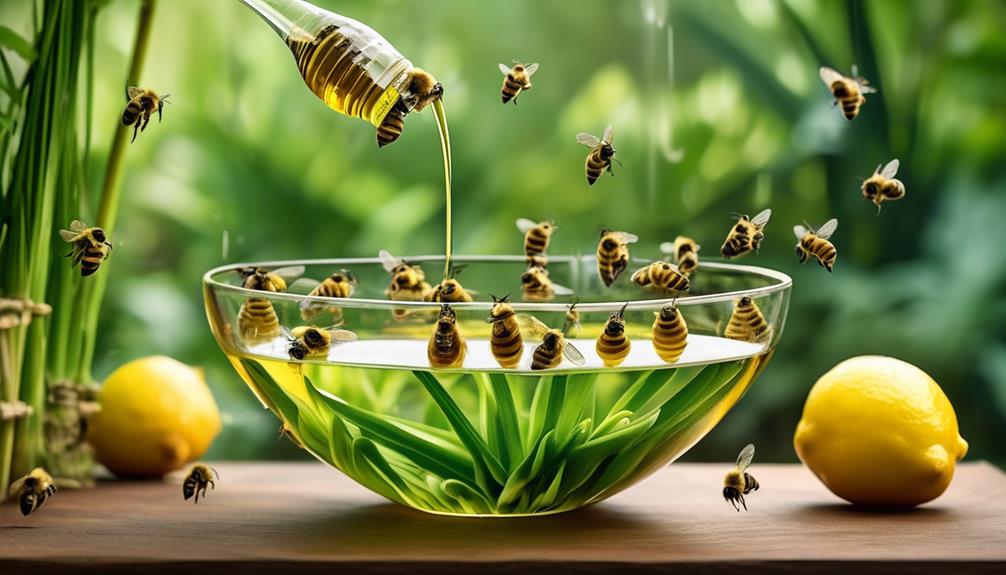
Having gathered all your essential supplies, your next step involves creating a safe and effective lemongrass oil mixture. This concoction forms the crux of your bee-attracting efforts, and it's crucial that you get it right.
First off, you'll need a base oil. This acts as a carrier for the lemongrass essential oil, diluting it to a safe concentration and facilitating its dispersion. A good choice here is almond oil, but coconut oil or olive oil can also serve the purpose.
Next, you'll add the lemongrass essential oil. The general rule of thumb is to maintain a 2% concentration, which equates to roughly 12 drops of lemongrass oil per ounce of carrier oil. Carefully count the drops as you add them to avoid overpowering the mixture.
Once you've combined these, give the mixture a thorough stir to ensure the essential oil is evenly distributed. Your lemongrass oil mixture is now ready for application. Remember, though, that lemongrass oil is potent. Always handle it with care and avoid direct contact with your skin.
With this mixture prepared, you're well on your way to successfully attracting bees.
Best Practices for Applying Lemongrass Oil
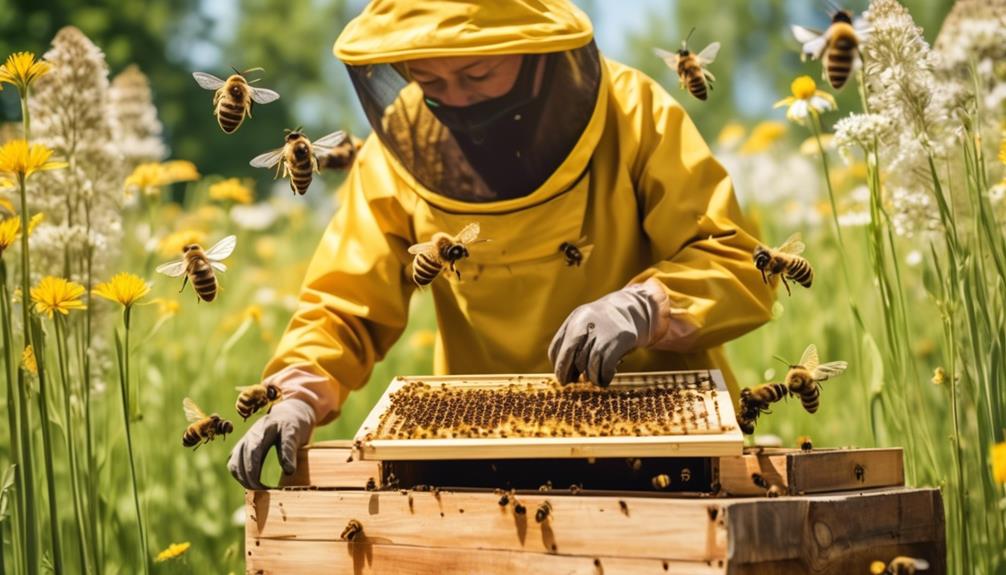
Now that your lemongrass oil mixture is ready, it's crucial you understand how to apply it correctly to maximize its bee-attracting potential. The most effective method is to dab a cotton swab with the mixture and lightly apply it on the entrance of the hive or bee trap. It's essential not to drench the area; a few drops will suffice.
Remember, this oil is potent, and overuse could overwhelm the bees and deter them. Also, refrain from applying the oil directly on the bees as it might've adverse effects on their health.
To maintain the scent, reapply the oil every few days or after heavy rains. It's worth noting that the oil's potency can decrease over time, especially when exposed to sunlight or extreme heat.
For a more significant effect, you can combine lemongrass oil with other bee-friendly scents like geranium and lavender. However, ensure to do this in moderation as a blend of too many strong scents can confuse the bees instead of attracting them.
Last but not least, always handle lemongrass oil with care. It's potent and can cause skin irritation or allergic reactions if not handled properly.
Monitoring Your Success and Troubleshooting
Once you've properly applied the lemongrass oil, it's essential to keep a close eye on your hive or bee trap to assess the effectiveness of your efforts and troubleshoot any issues that arise. Observe the frequency and pattern of bees visiting your setup. If the number of bees doesn't increase within a few days, you may need to adjust your approach.
Revisit your oil application method. Ensure you're using pure lemongrass oil and applying just the right amount. Too little won't attract bees, while too much can deter them. Make sure the oil is applied where bees will encounter it, ideally near the entrance of the hive or trap.
Take into account weather conditions. Bees are less active during cold and rainy days, which can affect their attraction to the scent. If weather conditions have been unfavorable, wait for a few sunny days and monitor the activity again.
Consider other factors that might be impacting bee attraction. Pesticides, loud noises, or other strong scents can turn bees away. Make sure your environment is as bee-friendly as possible.
With careful monitoring and troubleshooting, you can optimize your use of lemongrass oil to successfully attract bees.
Frequently Asked Questions
What Are the Potential Risks or Side Effects of Using Lemongrass Oil?
You might face some risks when using lemongrass oil. It's potent, so it can cause skin irritation or allergic reactions, particularly if you're sensitive. You should always dilute it before use.
Overconsumption can lead to dry mouth, increased urination, or even lung problems. It's also unsafe for kids and pregnant women. You mustn't use it near your eyes or mucous membranes.
It's best to do a patch test before using it extensively.
How Long Does It Usually Take for Bees to Be Attracted to the Lemongrass Oil Mixture?
You're wondering about the timeframe for bees' attraction to lemongrass oil. Generally, it can take anywhere from a few hours to a few days. It's dependent on factors such as the concentration of the oil, the proximity of the bees, and the local bee population.
Be patient, you'll notice a clear increase in bee activity around the area where you've applied the oil soon enough. Remember, nature works at its own pace.
Can Lemongrass Oil Harm My Plants or Other Insects in My Garden?
Lemongrass oil won't harm your plants or other insects in your garden. It's actually a natural pesticide that can deter harmful pests. However, it's always best to use it sparingly as some beneficial insects might also be deterred.
Be mindful about the concentration, too much could potentially harm plants. Always test on a small area first to ensure it's not causing any damage. The key is balance and careful application.
Are There Any Legal Restrictions or Guidelines for Using Lemongrass Oil to Attract Bees?
There aren't usually specific laws restricting the use of lemongrass oil.
However, you should check local regulations as some areas may have guidelines about attracting bees due to concerns about their health or human safety.
Additionally, you'll want to ensure you're not disrupting local ecosystems or causing harm to existing bee populations.
It's always best to consult with an expert or local authority before introducing any new attractants to your garden.
Can I Use Lemongrass Oil to Attract Other Types of Insects or Animals?
Yes, you can use lemongrass oil to attract other insects. It's not just bees that are drawn to its scent. Other insects such as butterflies and many types of beetles also find it appealing.
However, be cautious as it can also attract unwanted pests like mosquitoes. As for animals, it's less effective, but some, like cats, may be attracted to it.
Always remember to use it responsibly to avoid disrupting local ecosystems.
Conclusion
In conclusion, using lemongrass oil can greatly boost your success in attracting bees. Remember, preparation is key, and applying the oil correctly makes all the difference.
Monitor your results, tweak your methods if necessary, and celebrate your success. You're making a positive impact on our ecosystem by helping to pollinate plants and increase bee populations.
Keep up the good work, and happy beekeeping!

